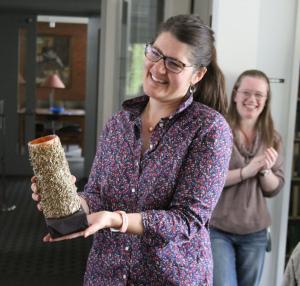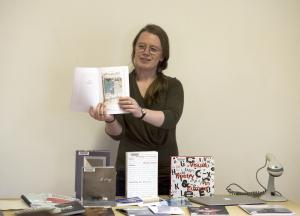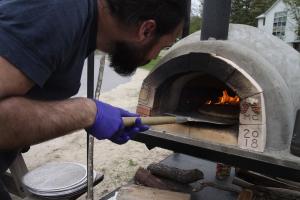Also of Note
 In May, library staff held their Second Annual Rice-Aron Library Rice Cook-Off, pitting staff members against each other in a heated competition for the best rice dish, literary alluding rice dish, or Rice-Aron Library–alluding rice dish. Despite some stiff competition from the likes of homemade mochi, dragon rolls, and a Rice Krispy treat in the shape of a mouse and called Of Rice and Men, the first prize went to Kate Trzaskos (pictured right), assistant dean of career education, for her cauliflower-rice A Tale of Two Rices. Kate will proudly display the coveted, rice-encrusted, gold-painted trophy until next year.
In May, library staff held their Second Annual Rice-Aron Library Rice Cook-Off, pitting staff members against each other in a heated competition for the best rice dish, literary alluding rice dish, or Rice-Aron Library–alluding rice dish. Despite some stiff competition from the likes of homemade mochi, dragon rolls, and a Rice Krispy treat in the shape of a mouse and called Of Rice and Men, the first prize went to Kate Trzaskos (pictured right), assistant dean of career education, for her cauliflower-rice A Tale of Two Rices. Kate will proudly display the coveted, rice-encrusted, gold-painted trophy until next year.
“I wanted to explain how I see in Spinoza’s philosophical system a way for white Americans to engage in antiracism work as a project of self-love and self-liberation,” says Anna Morrissey ’20, who presented their thoughts at a special summer Collegium Spinozanum at University of Groningen, Netherlands, in July. Anna went there with politics professor Meg Mott, who presented a paper on Spinoza and sexual violence at the same symposium. “Spinoza reveals that to ascribe to racist ideology, consciously or not, is to deny oneself a clear understanding of one’s reality, one’s power, and oneself,” says Anna, who was lauded by other participants for combining Spinoza and critical pedagogy.
In March, The Chronicle of Higher Education ranked Marlboro near the top of the heap in a list awkwardly titled “Where are students most and least likely to be taught by tenured and tenure-track professors?” Marlboro was ranked #2 among four-year private nonprofit institutions, bested only by—some of you may have heard of it—Yale University. Despite its diminutive size, Marlboro rose to the top of the list thanks to a high percentage of tenured or tenure-track faculty (87.5 percent) and the low ratio of students per tenured or tenure-track faculty (7:2). Read more.
 After a long wait and and much deliberation, in May the Campus Store announced the talented winner of the “New Fighting Dead Tree Design Contest.” Cedar Van Tassel ’21 topped the competition with an expertly rendered line drawing of a beady-eyed tree that looks pugnacious but not angry, rugged but not mean, dead, perhaps, but still full of that Marlboro fighting spirit (pictured right). “It was a close vote, but we hope everyone will join us in congratulating Cedar and celebrating our new Fighting Dead Tree,” says Sophie Gorjance ’16, campus store manager. “We will work to produce new swag for next year.”
After a long wait and and much deliberation, in May the Campus Store announced the talented winner of the “New Fighting Dead Tree Design Contest.” Cedar Van Tassel ’21 topped the competition with an expertly rendered line drawing of a beady-eyed tree that looks pugnacious but not angry, rugged but not mean, dead, perhaps, but still full of that Marlboro fighting spirit (pictured right). “It was a close vote, but we hope everyone will join us in congratulating Cedar and celebrating our new Fighting Dead Tree,” says Sophie Gorjance ’16, campus store manager. “We will work to produce new swag for next year.”
In April, students in SIT professor John Ungerleider’s Conflict and Identity class helped lead a dialogue workshop for the Pan-African Youth Leadership Program at the Vermont Statehouse in Montpelier. The program brings together high school students from across Africa with adult mentors for a three-week US-based training and cultural exchange, including learning about civic rights and responsibilities, respect for diversity, and the importance of community engagement. The Marlboro students were there to help John work with students and teachers from Uganda, Tanzania, Liberia, and Namibia about communication skills and the potential for civil dialogue in their communities and schools
In April, Lydia Nuhfer ’20 and Claire O’Pray ’20 presented a talk, “Digital Analyses of Royal Itineraries from the Crown of Aragon,” at the 40th Annual Medieval and Renaissance Forum at Keene State College. “We looked at digitized itineraries of the Crown of Aragon, using the travel patterns discovered in them to gain a better understanding of medieval travel and how a king’s travel patterns might have affected his reign or geopolitics,” says Claire. Using royal itineraries from between 1291 and 1410, they produced maps and other visualizations to examine differences in travel habits among rulers, in varying political climates, and within individual reigns.
 In May, Sophie Gorjance ’16 (pictured right) offered a public presentation in Apple Tree titled “Sensations of Understanding,” the culmination of her year as a postgraduate library fellow. Her fellowship project focused on the many ways the form of a book can convey information and meaning, and can shape one’s experience of “reading.” Specifically, she explored examples of wordless books, concrete poetry books, and books for sensory-impaired individuals, all of which she gathered for the library’s collection. She also discussed how this project grew out of her Plan work in creative writing, and how it fit into the fellowship as a whole.
In May, Sophie Gorjance ’16 (pictured right) offered a public presentation in Apple Tree titled “Sensations of Understanding,” the culmination of her year as a postgraduate library fellow. Her fellowship project focused on the many ways the form of a book can convey information and meaning, and can shape one’s experience of “reading.” Specifically, she explored examples of wordless books, concrete poetry books, and books for sensory-impaired individuals, all of which she gathered for the library’s collection. She also discussed how this project grew out of her Plan work in creative writing, and how it fit into the fellowship as a whole.
In June, Patrick Connelly (dean of students), Catherine O’Callaghan (assistant dean of academic advising), and Kate Trzaskos (assistant dean of career education) joined other college teams attending a Life Design Studio, a four-day immersive training in “life design,” at Stanford University. “Life design comes to Marlboro!” says Kate. “We’re bringing back ideas and curriculum to use with Marlboro students, starting with our first years in all First Year Seminars.” Founded by Bill Burnett and Dave Evans, authors of Designing Your Life, the Life Design Lab applies the principles of design thinking to approaches to college, career, and other life choices.
 Michael Riley ’09, IT director, has been seen making one or two pizzas in the new portable pizza oven, crafted by students working with ceramics fellow David Eichelberger.
Michael Riley ’09, IT director, has been seen making one or two pizzas in the new portable pizza oven, crafted by students working with ceramics fellow David Eichelberger.
 The staff-faculty team, Grim Sweepers, won the annual broomball competition in February, showing students that there is more to life than being young and flexible. Photo by David Teter ‘20
The staff-faculty team, Grim Sweepers, won the annual broomball competition in February, showing students that there is more to life than being young and flexible. Photo by David Teter ‘20
 In July, excavation started for the new dormitory building to replace Howland, known by students as “New Howland.” No sign of Emily Mather’s grave yet (see “Hauntings on the Hill”).
In July, excavation started for the new dormitory building to replace Howland, known by students as “New Howland.” No sign of Emily Mather’s grave yet (see “Hauntings on the Hill”).
 Who are these people? In February, familiar staff members and students took on unfamiliar personas for the annual “Dress for Success” event, part of Career Week. Photo by Clayton Clemetson ‘19
Who are these people? In February, familiar staff members and students took on unfamiliar personas for the annual “Dress for Success” event, part of Career Week. Photo by Clayton Clemetson ‘19
